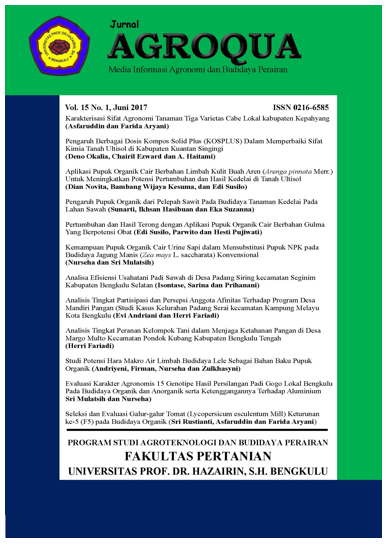RESPON PERTUMBUHAN DAN HASIL BAWANG MERAH (Allium ascalonicum L.) PADA PEMBERIAN PUPUK KANDANG KOTORAN SAPI DAN SEKAM PADI
DOI:
https://doi.org/10.32663/ja.v21i1.3927Keywords:
cow manure, rice husk, shallotsAbstract
This research aims to determine the effect of cow manure and risk husk on growth and yield of shallot. The research was carried out from February to June, located Kungkai Baru Village, Air Periukan Sub-District, Seluma District. The design used was a Completely Randomized Block Design with 2 (two) treatments and three replications. The first treatment was the dose of cow manure, which consisted of three levels : 10 ton/ha, 20 ton/ha, and 30 ton/ha. The second treatment was the dose of rice husk, which consists of three levels : 10 ton/ha, 20 ton ha, and 30 ton/ha. The results of the analysis of variance were continued with the Duncan’s Multiple Range Test with a test level 5%. The treatment of the study concluded that the dose of rice husk treatment had a significant effect on plant height two and four weeks after planting and leaf number two weeks after planting. The treatment of cow manure all observed variables had no significant effect. The result showed that the interaction the dose of cow manure and rice husk had a significant effect on the number of tubers per clump, fresh tuber weight and production per plot. The application of cow manure fertilizer at 10 ton/ha and rice husks at 30 ton/ha was the best treatment and gave the highest yield of shallots, tubers per clump was 4,25 cloves of shallot, fresh tuber weight was 36,25 g, and production per plot was 237.19 g/m2.
Downloads
Published
Issue
Section
License
Authors who publish with this journal agree to the following terms:
- Authors grant the journal right of first publication with the work simultaneously licensed under a Creative Commons Attribution 4.0 Internasional (CC BY 4.0) Licence that allows others to use and share the work with an acknowledgment of the work's authorship and initial publication in this journal.
- The author(s) still hold the copyright of his/her/their work and retain publishing rights without restrictions such as (but not limited to) patent right, lecture, book and reproduce the article for own purposes.
















